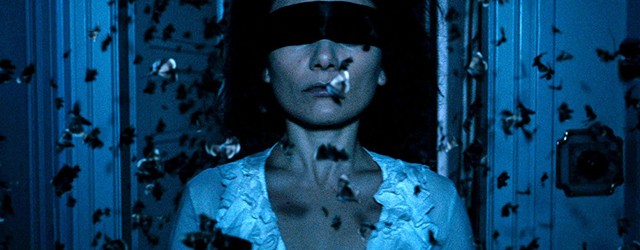Cinema | October 30th, 2015

A carefully crafted homage to sensualist 1970s European exploitation cinema in general and the work of filmmaker Jess Franco in particular, Peter Strickland’s “The Duke of Burgundy” bestows many perverse pleasures upon its viewers. Beautifully designed, confidently structured and filled with visual and aural luxuries, the story alights on the strained and idiosyncratic relationship between two insect researchers/enthusiasts whose intense study of lepidopterology and entomology approaches Nabokovian levels of poetic expressiveness, especially when combined with the BDSM being practiced by the lovers behind closed doors.
Our introduction to Evelyn (Chiara D’Anna) indicates that she serves as the submissive of Cynthia (Sidse Babett Knudsen), a stern taskmistress who metes out humiliations for the tiny infractions and mistakes committed when Evelyn falls short keeping house and polishing boots properly. Things are not what they seem, however, as Strickland reveals that Evelyn essentially “tops from the bottom,” scripting the exchanges that always lead to her sexual punishments. The more time we spend in the company of the two women, the more the director plays with the idea that Cynthia is a reluctant dominant who mostly, if not only, plays her role to please Evelyn.
Strickland uses the unorthodox particulars of Evelyn’s fantasies to examine the emotional connection between his two protagonists. The erotically charged novelties that constitute Evelyn’s desires — from the repetition of being scolded for failing to properly hand wash Cynthia’s undergarments to confinement in a locked trunk — are presented by Strickland with a great deal of restraint, deliberately leaving much to the imagination. Unlike many of Franco’s films, “The Duke of Burgundy” does not feature nudity. As Strickland goes deeper, he divulges a much stronger interest in the things we do for love rather than any of the “deviant” practices of Evelyn and Cynthia.
Whether one more closely identifies with Evelyn’s need to have her meticulously planned scenarios realized or with Cynthia’s frustration at the ongoing performance requirements and demands, Strickland manages to locate the most basic kinds of conflicts that can affect even the most vanilla partnerships. The movie’s deep respect for interpersonal universals contrasts with the ambiguity of the setting and time period. Like the vaguely anachronistic objects that flavor the films of Wes Anderson (though the filmmakers significantly differ in style), Strickland concocts a universe rife with antiquated technologies that suggest a fantasy space without a fixed year and out of step with 2015, even if the events shown could be happening now.
“The Duke of Burgundy” contains plenty of icebox talk to merit post-screening conversations or invite multiple viewings. While the primary interactions involve Evelyn and Cynthia, all of the supporting players in Strickland’s cast are female, from the curious specialist identified in the credits as “The Carpenter” to the entirety of the audience of academics who attend lectures on the moths and butterflies that serve as the film’s primary metaphoric motif (and provide the evocative title). The end credits, with the same sense of sly humor that courses through much of the film, delightfully lists a roll call of featured insects along with the human performers.
“The Duke of Burgundy” is now available on Netflix instant watch and other platforms.
December 16th 2025
December 9th 2025
December 2nd 2025
November 24th 2025
November 18th 2025
_(1)__293px-wide.jpg)
_(1)__293px-wide.png)
__293px-wide.jpg)

_(1)_(1)_(1)__293px-wide.jpg)
